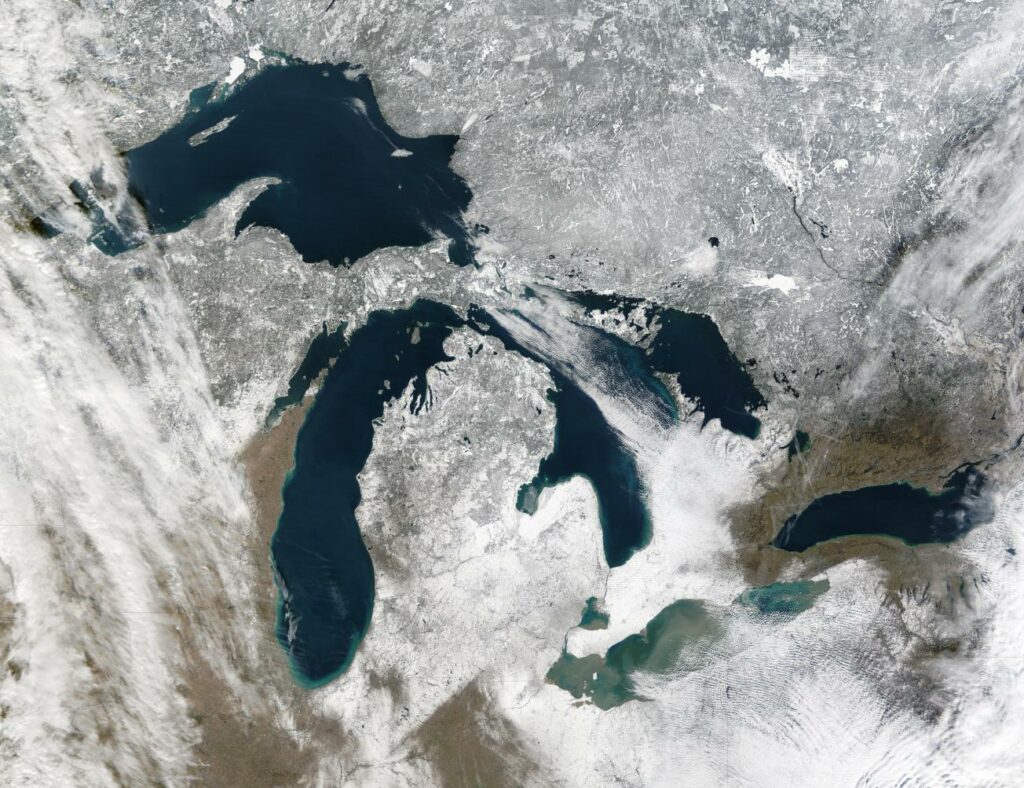
Reporting by Helen Hill for MITgcm
Watersheds deliver numerous pollutants to the coastline of oceans and lakes, thereby jeopardizing coastal ecosystems. Regulatory frameworks for stressors often focus on loading rates without accounting for the physical dynamics of the receiving water body. In a new study Lucas Gloege (LDEO, University of Columbia) and Galen McKinley (LDEO, University of Columbia), Robert J. Mooney (University of Wisconsin), J. David Allen (University of Michigan), Matthew W. Diebel (Dane County Land and Water Department), and Peter B. Mcintyre (Cornell University) have been using an MITgcm-based three-dimensional hydrodynamic model of Lake Michigan they have developed to simulate tributary-delivered anthropogenic pollutant transport. The paper is accepted at Environmental Research Letters.
“The Great Lakes are a treasured natural resource that contain over 80% of North America’s surface freshwater,” says lead author Gloege. “Tributary nutrient loads degrade Great Lakes coastal ecosystems and services they provide, including drinking water, fisheries, and recreation. In Lake Michigan, open-lake total phosphorus concentrations are below Great Lakes Water Quality agreement target concentrations but are elevated in the coastal zone. We set out to develop a realistic three-dimensional hydrodynamic model of Lake Michigan to highlight the role of lake hydrodynamics in the redistribution and trapping of tributary-derived pollution loads.”

Maximum generic tracer concentration with the 11 rivers marked and segregated into North, East, and West groups. The watershed is shaded in dark gray with sub-basins delineated by hydrologic unit codes – from Gloege et al 2020.
Gloege et al’s simulations suggest that a strong off-shore temperature gradient acts as a conduit for tributary-derived pollution, which amplifies the concentration near the coast and impairs coastal services.
“Simulating pollutant plumes from 11 rivers, and their intersections with coastal ecosystem services, reveals strong mediation of potential impacts by lake physics,” says Gloege. “Our study confirms that trapped pollutants accumulate in nearshore waters during spring peak flows, and become diluted by spreading offshore during the summer.”
The team’s simulations also show that the threat to coastal ecosystem services posed by pollutant loading differs sharply among rivers. “We found high potential impact arises from the spatiotemporal coincidence of tributary input rates, lake mixing dynamics, and multiple human uses of the shoreline,” says Gloege.
“Our simulations demonstrate that the physical dynamics of large water bodies can create a dynamic stressor landscape arising from multiple independent sources of non-point source pollution,” says Gloege. “The design and implementation of pollution regulations rarely account for spatial and temporal complexities of load processing in receiving waters, yet the resulting variability is likely to strongly mediate impacts on society. As hydrodynamic models improve, we hope our analytical framework could be applied to a wide range of pollutants and water bodies to enhance the sustainable use of coastal ecosystems.”
To find out more about this work contact gloege@ldeo.columbia.edu
Story image credit: Jeff Schmaltz, MODIS Rapid Response Team, NASA/GSFC
Related
Lake Modeling MITgcm Blog
About the Researcher

Lucas Gloege recently received his PhD in earth and environmental sciences from Columbia University in 2020. He has been using MITgcm since 2015. When he’s not hard at work modeling Lake Michigan, Lucas says he enjoys attending concerts.
This Month’s Featured Publication
Lucas Gloege et al (2020), Lake hydrodynamics intensify the potential impact of watershed pollutants on coastal ecosystem services, Environ. Res. Lett., doi: 10.1088/1748-9326/ab7f62
Other New Publications this Month
Victoria Boatwright and Baylor Fox-Kemper (2021), Biological and Physical Interactions at Local Ocean Scales: Coupled Systems, Georgetown Scientific Research Journal, doi: 10.48091/DNPR7287
Yan Du et al (2021), Ocean surface current multiscale observation mission (OSCOM): Simultaneous measurement of ocean surface current, vector wind, and temperature, Progress in Oceanography, doi: 10.1016/j.pocean.2021.102531
Ch Helling et al (2021), Cloud property trends in hot and ultra-hot giant gas planets (WASP-43b, WASP-103b, WASP-121b, HAT-P-7b, and WASP-18b), arXiv: 2102.11688 [astro-ph.EP]
C.S. Jones and Ryan P. Abernathey (2021), Modeling water-mass distributions in the modern and LGM ocean: circulation change, isopycnal and diapycnal mixing, Journal of Physical Oceanography, doi: 10.1175/JPO-D-20-0204.1
Kelly, T.B. (2020), Not Just Sinking Particles: Export and the Biological Carbon Pump in a Three-Dimensional Ocean Driven by Circulation and Vertical Migration, Florida State University Doctoral Dissertation, ProQuest: 28153263
Jody M. Klymak, Dhruv Balwada, Alberto Naveira Garabato, Ryan Abernathey (2021), Parameterizing non-propagating form drag over rough bathymetry, Journal of Physical Oceanography, doi: 10.1175/JPO-D-20-0112.1
Tongya Liu, Hsien-Wang Ou, Xiaohui Liu, Dake Chen (2021), On the Role of Eddy Mixing in the Subtropical Ocean Circulation, ESSOAr, doi: 10.1002/essoar.10506284.1
Guokun Lyu, Armin Koehl, Nuno Serra, Detlef Stamme, Jiping Xie (2021), Arctic Ocean‐Sea ice reanalysis for the period 2007‐2016 using the adjoint method, QJRMS, doi: 10.1002/qj.4002
Mariano, C., Marino, M., Pisacane, G., Sannino, G. (2021), Sea Level Rise and Coastal Impacts: Innovation and Improvement of the Local Urban Plan for a Climate-Proof Adaptation Strategy, Sustainability, doi: 10.3390/su13031565
Motoki Nagura (2021), Spiciness anomalies of Subantarctic mode water in the south Indian Ocean, Journal of Climate, doi: 10.1175/JCLI-D-20-0482.1
Yoshihiro Nakayama, Dimitris Menemenlis, Ou Wang, Hong Zhang, Ian Fenty, and An T. Nguyen (2021), Development of adjoint-based ocean state estimation for the Amundsen and Bellingshausen Seas and ice shelf cavities using MITgcm/ECCO, Geoscientific Model Development, doi: 10.5194/gmd-2020-421
Charline Ragon et al (2021), Robustness of Competing Climatic States, arXiv:2102.09418 [physics.ao-ph]
Michael Schindelegger, Alexander A. Harker, Rui M. Ponte, Henryk Dobslaw, David A. Salstein (2021), Convergence of daily GRACE solutions and models of sub-monthly ocean bottom pressure variability, JGR Oceans, doi: 10.1029/2020JC017031
Habib Toye, Peng Zhan, Furrukh Sana, Sivareddy Sanikommu, Naila Raboudi, Ibrahim Hoteit (2021), Adaptive ensemble optimal interpolation for efficient data assimilation in the Red Sea, Journal of Computational Science, doi: 10.1016/j.jocs.2021.101317
Vasiliy Vlasenko and Nataliya Stashchuk (2021), Setting tidal forcing for regional modelling of internal waves, Ocean Modelling, doi: 10.1016/j.ocemod.2021.101767
Shiming Xu, Jialiang Ma, Lu Zhou, Yan Zhang, Jiping Liu, and Bin Wang (2021), Comparison of sea ice kinematics at different resolutions modeled with a grid hierarchy in the Community Earth System Model (version 1.2.1), Geosci. Model Dev., doi: 10.5194/gmd-14-603-2021
Do you have news about research using MITgcm? We are looking for contributions to these pages. If you have an interesting MITgcm project (ocean, atmosphere, sea-ice, physics, biology or otherwise) that you want to tell people about, get in touch. To make a post, contact Helen
